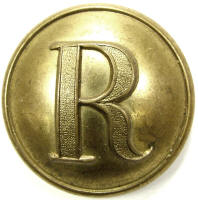
A virtual examination of artifacts of the American Civil War
by Harry Ridgeway
 |
Ridgeway Civil War Research Center, A virtual examination of artifacts of the American Civil War |
| Civil War Artillery | |
by Harry Ridgeway |
| Artillery projectile, canister, pattern with thin iron can, iron top and bottom, iron balls, wood cup sabot, 3.67 in. The canister was the artillerist's weapon of last resort. Once the enemy got close to the battery, the gunners would load these rounds, and the flimsy can would burst on firing sending the contents in scatter fashion against the troops charging the cannon. The fire was devastating against the troops but the enemy would be so close that options to reload and shoot would have been limited. The can was constructed of sheet iron, shaped into a cylinder, fitted around iron plates top and bottom, sides were brazed, a lip was left at the top and the bottom. A wood sabot was cut on a lathe, grooves were cut to tie the powder bag, the lower lip of the can was nailed to the wood sabot. The can was filled with balls, usually iron, packed in sawdust, once filled, the can upper lip was then folded around the top plate. Based on the diameter of this projectile, it is believed that this was intended for any 3.67in. cannon, either a smoothbore 6 pounder, rifled 6 pounder, or rifled 20 pounder. The canister was intended to burst immediately on firing, consequently the presence or absence of rifling would not have been important, and as a weapon of last resort, rounds could have been double or triple loaded without adversely stressing the cannon. Projectile measures: diameter 3.6in., overall length with sabot 6.75 in., canister only length 5.0in., weight 7.0lb. Research Center: Artillery2541-Canister, Ref: Dickey & George, Field Artillery (1993 Edition), pg. 54. Details click: http://relicman.com/artillery/Artillery2541-Canister.html. |
| A1719...Artillery projectile, canister, 3.67 in., top and bottom plates. Top and bottom plates from canister. Plates measure: diameter 3.5 in. Recovered: Vicksburg, Mississippi. |
| Ridgeway Civil War Research Center, A virtual examination of artifacts of the American Civil War. Artillery Research center, artillery, click: http://relicman.com/artillery/Artillery0000-Index.html. Research center, artillery, click: http://relicman.com/artillery/Artillery0000-Index.html. |
| Civil War Relicman, Harry Ridgeway, Civil War artillery, Relicman sales catalog. Click here: http://relicman.com/artillery/RelicmanSalesArtillery1.html. Artillery for sale: http://relicman.com/artillery/RelicmanSalesArtillery1.html. |